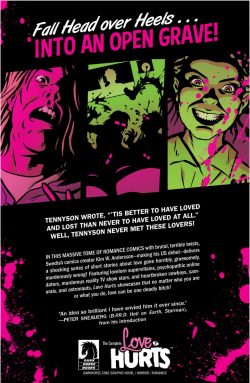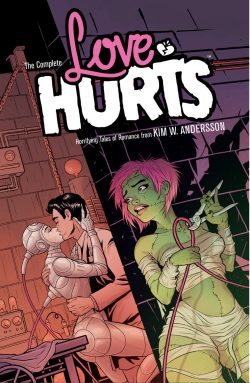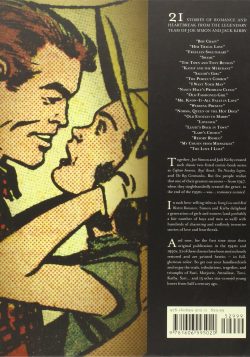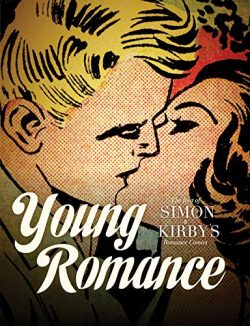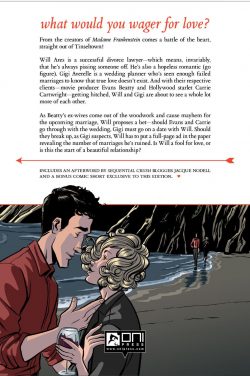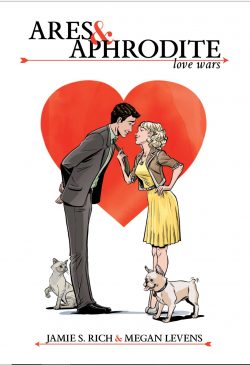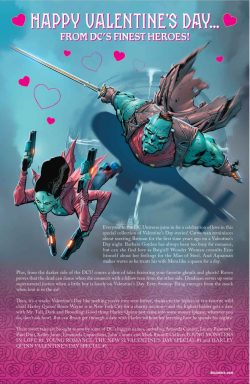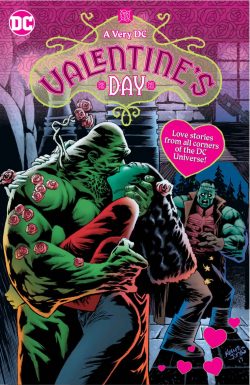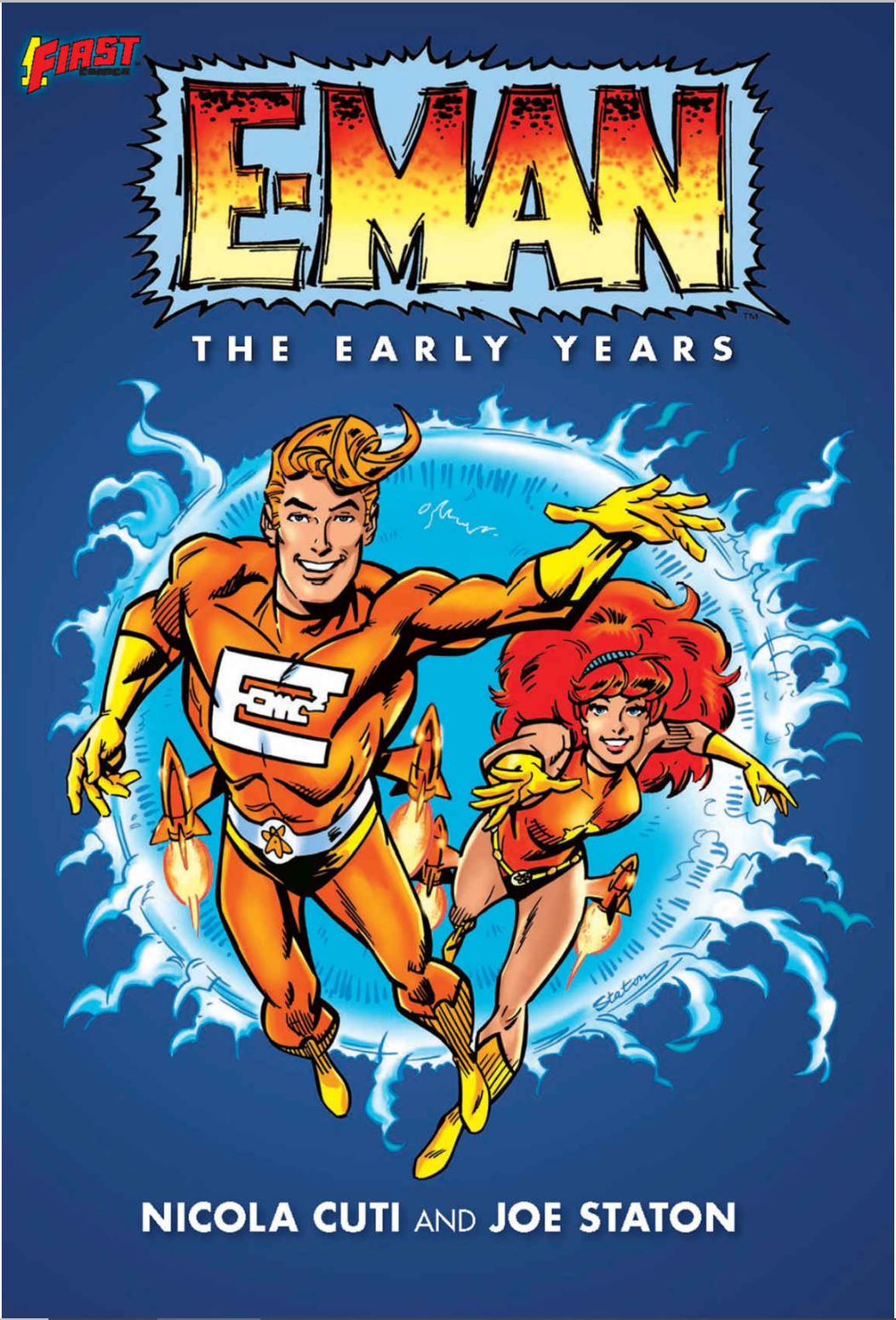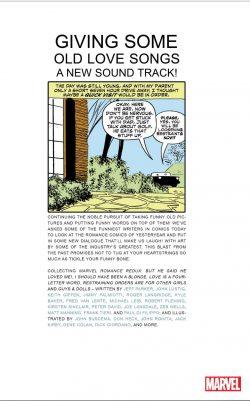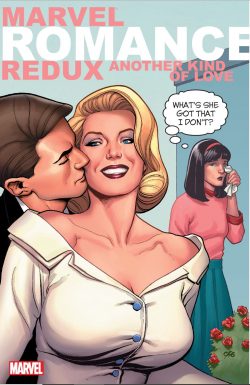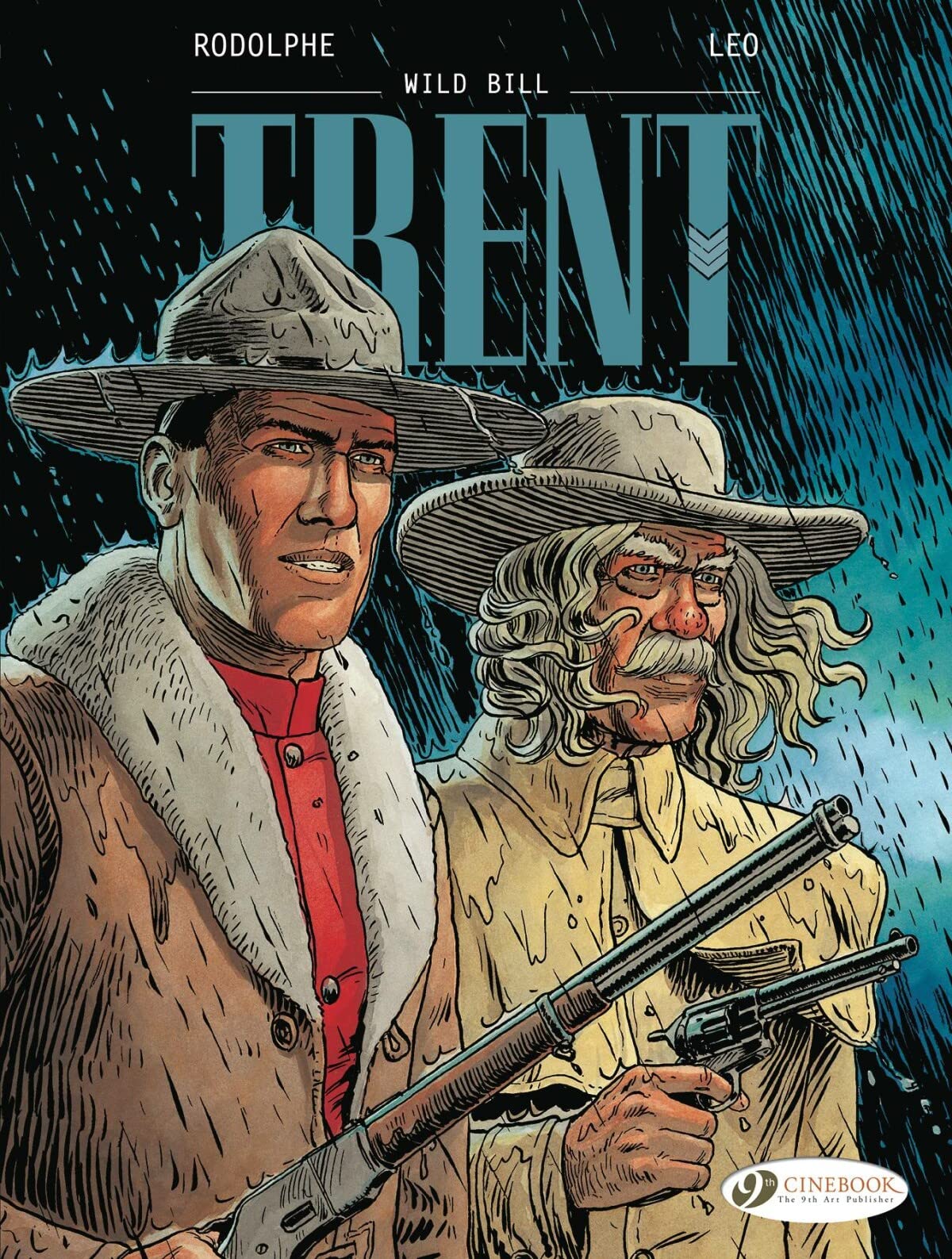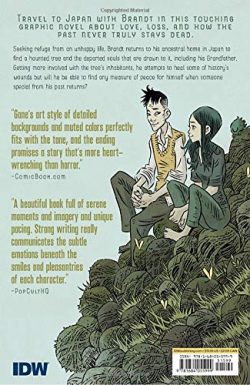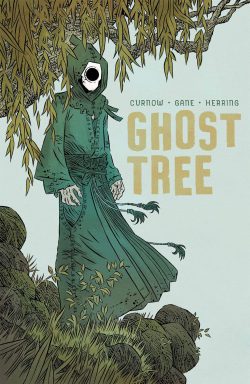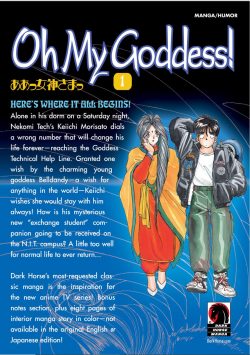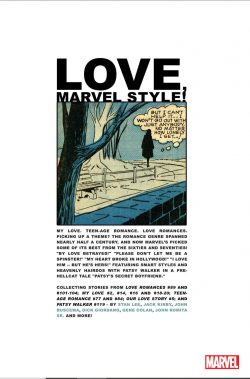
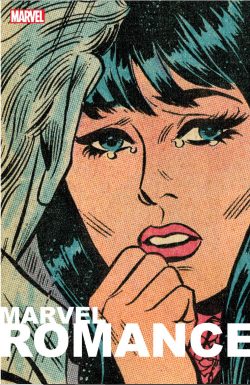
By Stan Lee, Larry Lieber, Jean Thomas, Gary Friedrich, Jean Thomas, Jack Kirby, Dick Giordano, Vince Colletta, Joe Orlando, Gene Colan, Al Hartley, Sol Brodsky, John Romita Sr., John Buscema, Jim Steranko, Don Heck, Bill Everett, Jim Starlin, Jack Abel, Jim Mooney, Frank Giacoia & various (Marvel)
ISBN: 978-0-7851-2089-6 (TPB/Digital edition)
It’s the officially mandated period for us all to boost the economy by thinking of Love, Happy Ever Afters and furtive desperate hooks-ups, so if you’re reading this rather than frantically swiping your way through TENDR, eHugmany, GRUMBLR or GREEBLR?, you are probably old, unhip (perhaps Replacement Hipped?) or just like comics.
Once upon a time, comic books were the singular first port of call for entertainment/hope deprived, lovelorn ladies of all ages, whilst many a baffled bloke consulted such publications for useful hints on how to approach their amatory prey – before donning metaphorical rutting stag antlers and putting all their time and efforts into a staggeringly (tee hee!) inappropriate and never-to-be-repeated grandstanding stunt that simultaneously stunned their potential inamorata and forever burned out all desire ever to be such a sappy silly bugger again.
Such is modern love…
However, over the decades, the commercial aspects of the never-ending battle generated pretty good stories and paid the bills of some of our artform’s greatest talents, and early in this century Marvel celebrated with a splendid archival gift for the fans…
As the escapist popularity of flamboyant superheroes waned after World War II, newer genres such as Romance and Horror came to the fore even as older ones regained their audiences. Some, like Westerns and Funny Animal comics, had hardly changed at all but crime and detective tales were utterly radicalised by the temperament of the times.
Stark, uncompromising, cynically ironic novels and socially aware, mature-themed movies that would become categorised as Film Noir offered post-war society a bleakly antiheroic worldview that often hit too close to home and set fearful, repressive, middleclass parent groups and political ideologues howling for blood.
Naturally, these new sensibilities seeped into comics, transforming two-fisted gumshoe and cop strips of yore into darkly beguiling, even frightening tales of seductive dames, big pay-offs and glamorous thugs. Sensing imminent Armageddon, America’s moral junkyard dogs bayed even louder as they saw their precious children’s minds under seditious attack…
Concurrent with the decline of masked mystery-men, industry giants Joe Simon & Jack Kirby famously invented the romantic genre for comic books: devising beguiling, explosively mature social dramas equally focussed on a changing cultural scene and adult themed relationships. They began with semi-comedic prototype My Date in early 1947, before plunging into the torrid real deal with Young Romance #1 in September of that year.
Not since the invention of Superman had a single comic book generated such a frantic rush of imitation and flagrant cashing-in. It was a monumental hit and “S&K” quickly expanded: releasing spin-offs Young Love (February 1949), Young Brides and In Love.
Simon & Kirby presaged and ushered in the first American age of mature comics – not only with their creation of the Romance genre, but with challenging modern tales of real people in extraordinary situations – before seeing it all disappear again in less than eight years.
Their small stable of magazines produced for the loose association of companies known as Prize/Crestwood/Pines blossomed and wilted as the industry contracted throughout the 1950s.
All through that turbulent period, comic books suffered impossibly biased oversight and hostile scrutiny from hidebound and panicked old guard institutions such as church groups, media outlets and ambitious politicians. A number of tales and titles garnered especial notoriety from those social doom-smiths, and hopeful celebration and anticipation amongst tragic, forward-thinking if psychologically scarred comics-collecting victims was quashed when the industry introduced a ferocious Comics Code that castrated the creative form just when it most needed boldness and imagination.
We lost and comics endured more than a decade and a half of savagely doctrinaire, self-imposed censorship.
Those tales from a simpler time, exposing a society in meltdown and suffering cultural PTSD, are mild by modern standards of behaviour, but the quality of art and writing make those pivotal years a creative highpoint long overdue for a thorough reassessment.
For years such Code-vetted romance comics were a comfortably profitable, solid staple of Marvel – as well as almost every other publishing house. It’s also a truism that girls are pickier than boys – or at least have more discerning tastes – so most of those titles, whilst extremely limited by editorial tastes in the stories they offered, were generally graced with some of the best artwork the industry could offer.
Those love-starved chicks might have been content to absorb the same old perpetually regurgitated characters and plot pablum, but they definitely, defiantly wanted it all to look the best it possibly could…
Having accepted that the art for comics aimed at females has always been of a higher standard and observed that many of Marvel’s greatest action illustrators have secretly toiled in the tear-sodden Hearts and Flowers mines, the wisely cynical Editorial heads at The House of Ideas released an archival edition of the best of the bunch in 2006. – just in time for St. Valentine’s day! – Marvel Romance. To cover all bases (third is my favourite!), they also released comedic one-shot versions: latterly collected as Marvel Romance Redux…
Contained herein are a selection of 1960s relationship yarns that cunningly show the formulaic nature of the genre at the time Marvel was revolutionising superhero comics, backed up by significant and memorable stories from the early 1970s when the company tried to repeat the process for the romance genre.
I fear it’s a subtly intrinsic indicator of the tone of the times and state of society, but you may notice how crying seems to be the natural resting state of women in romance comics, and love stories were always a good and sound excuse to show pretty girls in swimsuits or their underwear. As us guys always suspected, un- or semi-dressed was the fitting and proper state of females….
The amorous advances begin with the contents of Love Romances #89, cover-dated September 1960. Presumably scripted by Stan Lee and Larry Lieber, all are limned by Dick Giordano & Vince Colletta, opening with ‘I Mustn’t Love You, My Darling!’ as a woman seeking eligible bachelors almost misses out on a hot doctor due to her prejudices, after which the same attitude nearly saves a dishy director and producer from an aspiring actress who eventually decides he’s ‘The Only Man for Me’…
When a high school girl is let down and has ‘No Dates for the Dance!’, a little maternal advice leads to happy ending before ‘The Last Good-By’ reminds a woman of a smugly arrogant college flame and why she left him…
The romance market was always subdivided into niche categories and young love was catered too in books like Teen-age Romance. From September 1960, #77 spawned a brace of tales possibly drawn as well as inked by Colletta. ‘A Teen-Ager Can Also Love!’ revealed how one fan’s devotion saved the career of an up-&-coming crooner whilst ‘Someday He’ll Come Along’ showed how an ambitious and determined secretary became an ad exec and still got to marry the boss…
Cover-dated November 1961, Teen-age Romance #84 sees Jack Kirby excel in ‘The Summer Must End!’ (Lee script & Colletta inks) as a haughty and beautiful social butterfly – and predator – luxuriates in the pick of men before making the wrong choice and regretting it…
Gene Colan then renders a simple and charming story of instant connection in ‘He Never Said a Word’ from Love Romances #101 (September 1962) before one month later #102 serves up a double dose of magic from Lee, Kirby & Colletta when a bride-to-be jumps to a painfully erroneous conclusion in ‘By Love Betrayed!’ after which a graduate returns to the scene of her bitterest disappointment and finally bags the lecturer she was too young for in ‘Give Back My Heart!’
Cover-dated January1963, Love Romances #103 saw Kirby inked by Al Hartley in ‘The Dream World of Doris Wilson!’ – wherein a lonely outsider finds her perfect partner in a young comic book artist – and ‘If Your Heart I Break…’ depicting an imminent bride and groom both realising just in time the mistake they’re about to make…
The socially conformist sampling ceases with ‘Please Don’t Let Me Be a… Spinster!’ (Love Romances #104, March 1963 by what looks like Colletta inking Joe Orlando) as a young woman forgoes her own needs to care for her ailing mother. Just when all hope is lost, a dishy new doctor cures the elder and offers a new life for the dutiful daughter…
As already indicated, Romance played a big part in the Pre-Marvel Comics Atlas Era and next up is an issue of a teen star who was a big gun of that success.
Patsy Walker was an ideal girl-next-door whose wholesome teen-comedic exploits delighted readers for decades following her debut in Miss America #2 (Nov. 1944). She starred in seven separate comic series until 1967 and was dramatically retooled in the 1970s by Steve Englehart, Tom Sutton, George Pérez and others, eventually evolving into supernatural superhero Hellcat.
Patsy Walker #119 (November 1964) is by Lee & Sol Brodsky, revealing ‘Patsy’s Secret Boyfriend’, with the wholesome, decent teen star’s friends shocked and amazed by her apparent two-timing of high school sweetheart Buzz Baxter, in the days leading up to his coming home from the Vietnam war. Of course, there’s a sound and sensible reason for her actions that everyone has completely misunderstood…
This segment also includes the issue’s perennially adored style and clothing tips courtesy of ‘Patsy, Hedy and Nan’s Smart Styles’, ‘Patsy’s Fashion Page’, ‘Hedy’s Fashion Page’, ‘Patsy’s Heavenly Hairdos’ and ‘Hedy’s Charming Coiffures’. There are naturally lots of underwear moments…
After utterly changing the superhero scene, Stan Lee turned his attentions to reviving the ailing fortunes of the moribund romance division. Unlike competitors DC and Charlton Comics, Marvel’s comparatively limited creative resources and restrictive distribution contracts meant that the love anthologies had to go as the costumed cohort proliferated.
However, in 1969, with a new distributor and a burgeoning creative workforce, Marvel launched anthologies My Love (volume 2) and Our Love Story: offering new, edgier, contemporary stories by top flight writers and artists. Arguably, the project was a rare failure, but both books carried on into 1976, releasing 39 and 38 issues respectively, even though by 1972 new stuff was increasing supplemented by modified and updated reprints.
Again, the tales were heavily geared towards images of beautiful girls in glamorous roles and poses…
Here we begin with ‘I Do My Thing… No Matter Whom It Hurts!’ by Lee, John Buscema & John Romita Sr. as first seen in My Love #2 (cover-dated November 1969): the tale of a lovely but self-serving go-go dancer who learns too late that selfishness is its own punishment, after which Lee & Jim Steranko’s landmark pop-art masterpiece gets another airing. After debuting in Our Love Story #5 (June 1970) ‘My Heart Broke in Hollywood!’ was acclaimed as a breakthrough in graphic storytelling, although the story is a simple one of an aspiring actress losing a role but gaining a husband. Visually, it alone is worth the price of this book…
Lee, Don Heck & Romita Sr. then depict how a lonely, oblivious lass is ‘Jilted!’ (My Love #14, November 1971) and discovers that her true love has been right beside her all along, whilst Gary Friedrich, Colan & Giordano delve deep into hero-worship in My Love #16’s ‘As Time Goes By!’: exploring how a modern woman obsessed by Humphrey Bogart in Casablanca is returned to reality by a determined former boyfriend. The same issue – cover-dated March 1972 – also provides the ‘Formula for Love!’ with Jean Thomas, Colan & Bill Everett collaboratively proving that even a tutor-obsessed chemistry student can find true love, even after acting like a (Sandra) bullock in a china-shop, setting herself on fire and soaking the lab…
A deeply dissatisfied nurse then discovers ‘Another Kind of Love!’ (My Love #18, July 1972 by Lee, John Buscema & Colletta), ditching her dull banker boyfriend for a patient with months to live, whilst Romita Sr.-inked Lee & JB’s ‘I Love Him… But He’s Hers!’ (My Love #19, September 1972) sees a hardworking waitress/poor college student find her man when her work ethic outshines the wealth, glamour and self-indulgence of her spoiled competitor dorm roommate…
The dalliances close with a trio of tales from My Love #20 (November 1972), starting with Friedrich, Jim Starlin & Jack Abel’s ‘One Day a Week!’ as a diner waitress is beguiled by a fancy man who is there all the time – unlike her trucker fiancé…
Lee, John B, Romita Sr. & Frank Giacoia turn the tables on expectation in ‘Love Isn’t in the Cards for Me!’ as a charming conman selling a shop owner a line ultimately redeems himself, after which Lee, Colan & Jim Mooney wrap things up revisiting an old story of betrayal by a best friend when a conflicted woman remembers ‘The Boy That Got Away!’…
For many, love stories are just an inaccessible “other country”, but even the most formulaic of these tales are beautiful examples of comics creation and if you can unbend a bit – and swallow some painfully outdated notions and attitudes – these mini-dramas can still delight and enthral. Why not take a chance on love and see what’s in it for you?
© 2020 MARVEL.
